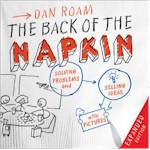 |
|
|
| ||||||
|
|
This page is the original source of this review, though you may also find it on Amazon or other sites. | ||
| Book Reviews Home | Free Audio Books | |
 |
Book Review of: The Back of the NapkinSolving Problems and Selling Ideas with Pictures Price: From $8.94 |
| Review
of
The Back of the Napkin, by Dan Roam (Hardcover, 2008) (You can print this review in landscape mode, if you want a hardcopy) Reviewer: Mark Lamendola, author of over 6,000 articles. As someone who has long made a practice of drawing and/or gesturing while talking (talking with your hands, some people call it), I felt drawn to this book (no pun intended). I agree with most of the author's general comments, and I admire him for coming up with a symbol/drawing system that is logical and, if used properly, powerful. I think if your job or pastime requires you to play the persuasion game, it's worthwhile to learn some kind of system that allows you to draw quickly and efficiently. Roam has such a system. This book consists of four parts. If you read just the first part, you get that warm feeling that comes from having grasped some pretty useful concepts. The other three parts show the techniques Roam uses, and these can make you feel a little lost. Unless you intend to study and learn his specific techniques, these last three parts are better skimmed than read. He uses a specific case history, and you watch this evolve from very simple through various stages to the final step. This case history makes up, by far, the bulk of the book.
Once you understand the basic concept, you could stop reading as you finish Part 1 (it ends on page 45). The rest of the book walks you through a long example of how to use the concept. Personally, I find this system to be too complicated to adopt for my own use. I have better uses for the time it would require to learn and practice, as it doesn't solve a problem I have. But that is only my situation; yours may be entirely different. For the small price of this book, you may want to buy a copy and judge for yourself. The book's cover is 49 square inches in area (7H x 7W) and 260 pages long (278 pages, if you count the appendices and index). There is a newer, expanded version out now. I don't see the purpose of it, unless you want to study and adopt Roam's system as your own. This brings us to my statement that I agree with most of the author's general comments. Where I disagree is his opinion that you have to draw pictures to communicate effectively (that, at least, seems to be what he's saying--repeatedly). I think if you hone your verbal, written, and composition skills to such a level that you can score 90% or higher on a test of Standard Written English, you will have the ability to effectively communicate. All investments of time and money have opportunity costs. If you can't score highly on a test of SWE (few Americans can), then you should first learn English well enough to do that. Only then should you enhance your communication skills by adding the pictorial method. Then again, it may be that using a pared-down version of Roam's method could help anyone be a better student of English. | |
About these reviewsYou may be wondering why the reviews here are any different from the hundreds of "reviews" posted online. Notice the quotation marks? I've been reviewing books for sites like Amazon for many years now, and it dismays me that Amazon found it necessary to post a minimum word count for reviews. It further dismays me that it's only 20 words. If that's all you have to say about a book, why bother? And why waste everyone else's time with such drivel? As a reader of such reviews, I feel like I am being told that I do not matter. The flippancy of people who write these terse "reviews" is insulting to the authors also, I would suspect. This sound bite blathering taking the place of any actual communication is increasingly a problem in our mindless, blog-posting Webosphere. Sadly, Google rewards such pointlessness as "content" so we just get more if this inanity. My reviews, contrary to current (non) standards, actually tell you about the book. I always got an "A" on a book review I did as a kid (that's how I remember it anyhow, and it's my story so I'm sticking to it). A book review contains certain elements and has a logical structure. It informs the reader about the book. A book review may also tell the reader whether the reviewer liked it, but revealing a reviewer's personal taste is not necessary for an informative book review. About your reviewer
About reading styleNo, I do not "speed read" through these. That said, I do read at a fast rate. But, in contrast to speed reading, I read everything when I read a book for review. Speed reading is a specialized type of reading that requires skipping text as you go. Using this technique, I've been able to consistently "max out" a speed reading machine at 2080 words per minute with 80% comprehension. This method is great if you are out to show how fast you can read. But I didn't use it in graduate school and I don't use it now. I think it takes the joy out of reading, and that pleasure is a big part of why I read. |
| |||||